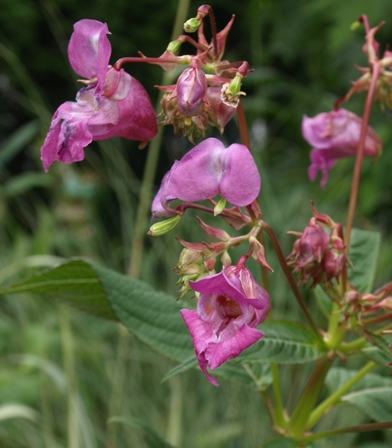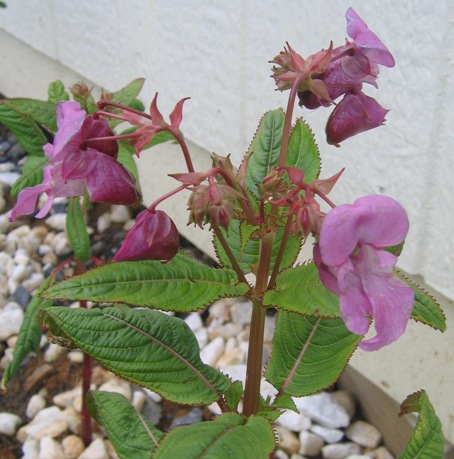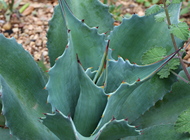 |
Impatiens glandulifera |
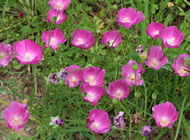 |
|
| 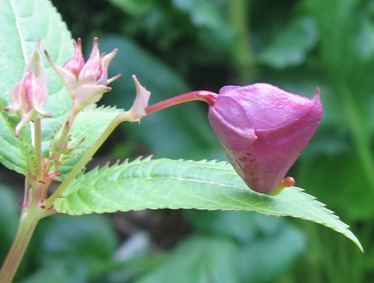
| | Cool buds |
|
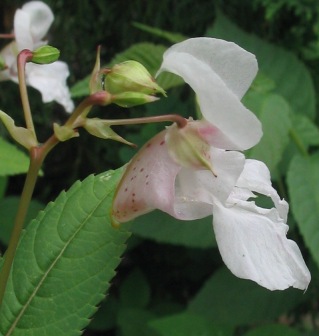
| | One of the plants came out white |
| Common name |
policeman's helmet; Himalayan balsam |
| Family |
balsaminaceae |
| Life cycle |
annual |
| Flowers |
pink |
| Size |
4-6' |
| Light |
sun-part shade |
From seed  |
Give several weeks cold, then move to room temperature; germination may start during cold stage.
detailed seed-starting info below
|
| Seed ripens | late July |
I first saw this on a business trip to Siberia, and was surprised to see it in many gardens, whereas I was unfamiliar with it. I took a few photos, which helped identify the plant, and managed to trade for seed the next year. A tall annual, it is very ornamental, but apparently it can be invasive in certain climates.
|
This plant used to grow in our garden, but it slipped away... One or more images of this plant are included in my stock photo catalog About my plant portraits
PlantLinks to other web pages about Impatiens glandulifera
Visitors to this page have left the following comments| john paterson | May 13, 2008 | Hi Rob,
I garden in Calgary and the Impatiens glandulifera is VERY invasive here. Each plant produces several hundred seeds and spits them up to five meters away from the main plant. I'm pretty sure every one of the seeds germinates, as I had to pull several hundred out of my garden last spring. The two-leaf stage looks remarkably like a sunflower seedling with a touch of red colour at the stem. The main leaves come out at 120 degrees around the hollow stem.(not one of my favorite plants here.
cheers - john
I certainly get my share of volunteers, but I'm not yet bothered by them - they're easy to pull up where I don't want them. I can see how a large stand of them would get to be a problem, though. |
| Lorraine | Sep 06, 2008 | Here in the uk a number of councils now have issued warnings regarding the spread of this plantas follows Himalayan balsam
Himalayan or Indian balsam (Impatiens glandulifera) was introduced to Britain in 1839, but escaped from gardens and rapidly colonised riverbanks and areas of damp ground. Himalayan balsam grows in dense stands that suppress the growth of native grasses and other flora. In the autumn, the plants die back, leaving the banks bare of vegetation and vulnerable to erosion.
Facts and figures
Native range: Western Himalayas
Stem: Pinky-red colour
Up to 3m tall - tallest annual plant in Britain
Hollow and jointed
Sappy and brittle
Leaves: Spear-shaped, with serrated edges
Shiny and dark green with a dark red midrib
Up to 150mm long
Opposite or in whorls of three
Flowers: Purplish-pink to pale pink
Slipper-shaped, on long stalks
June – October
Seeds : White, brown or black
Produced from July – October
4-7mm diameter
4 – 16 seeds per pod
Control: Control measures should aim to prevent flowering and if this is achieved before seeds are set, eradication is possible in two to three years.
Chemical control: can use glyphosate or 2,4-D amine. Need to be used whilst plant is actively growing in early spring for best effect.
Cutting/mowing/strimming: cut at ground level using a scythe, before the flowering stage in June. Do not cut earlier as this promotes greater seed production in any plants that regrow. Cutting should be repeated annually until no more growth occurs.
Pulling: shallow-rooted plants can be pulled up very easily and disposed of by burning or composting, unless seeds are present.
Grazing: Grazing by cattle and sheep is effective from April throughout the growing season. It should be continued until no new growth occurs.
Hope this helps people to manage this plant as it is quite pretty. |
| Lea | Jul 09, 2010 | Hi,I purchased a few Balsam plants early in the season. I brought them home and at first was frustrated in the fact that they looked awkward amoung my other plants. They quickly grew into a very full plants that I had to move into large planters and I am now in love with these beautiful annuals. I recently noticed though that I have quite a few seedlings starting in the graden where they were first planted, as well as in their planters. I am curious if I would be able to bring them indoors for the winter and keep them alive? Otherwise I don't see much point in letting the seedlings grow. any tips?
These are large plants, and I believe they are true annuals. So they are not good candidates for overwintering. Instead, try to collect some seed, so that you'll have some to spread around next spring. You'll probably have more volunteer seedlings then as well, but it's good to have some insurance in the form of collected seed. |
| Diane | Jan 30, 2011 | I heard the seeds taste like walnuts. Are they safe to eat? |
| Manuel probst | May 15, 2011 | I'm interested in buying some of these Impatients glandulifera because. When I was kid in Berlin we would sqeeze the seed pod and they would twist and shoot out. However that variety was yellow. Do you have any of those and how much would they be?
Manuel
Sounds like a different species of Impatiens. I don't have it, though. |
- Seed from '05 trade. Baggy 35F (4w; 20%G, 4w) - 70F (40%G, 1-6d)
- Seed from '06 garden. Baggy 35F (22d; 43%G, 22d) - 70F (14%G, 2d)
Grows fast and stocky - don't start too early!
I welcome comments about my web pages; feel free to use the form below to
leave feedback about this particular page. For the benefit of other visitors
to these pages, I will list any relevant comments you leave, and if
appropriate, I will update my page to correct mis-information. Faced with an
ever-increasing onslaught of spam, I'm forced to discard any comments including
html markups. Please submit your comment as plain text. If you have a
comment about the website as a whole, please leave it in my
guestbook. If you
have a question that needs a personal response, please
e-mail me.
Last modified:
June 28, 2008
Contact me
|


